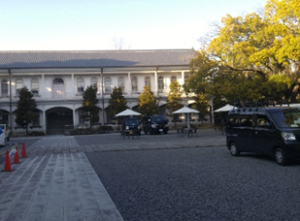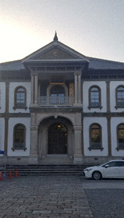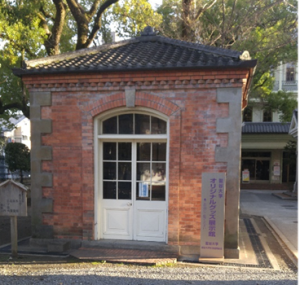A university building designated as an important cultural property in Kyoto City ~Ryukoku University Omiya Campus~
Yoshie Doi

Hokkou |

Main house |

Guardhouse (Important Cultural Property) Photographed on February 28 |
Kyoto, a university town, has many academic buildings that are designated as important cultural properties or registered tangible cultural properties. We can enjoy the atmosphere of the Meiji era just by visiting the school buildings of Kyoto University, Ryukoku University, Doshisha University, and Otani University.
There are 37 universities and junior colleges in Kyoto City, and the number of students is 136,000, making it the number one university city in Japan. Approximately 10% of the population in Kyoto City are university students. Kyoto is unique in that it has many cultural properties, not only shrines and temples, but also university buildings.
The group of Western-style buildings built in 1888, such as Ryukoku University’s Omiya Gakusha, shows the efforts of carpenters who created traditional wooden structures in a Western style. Stones are attached to wooden pillars. The fact that many of the Western buildings of the Meiji era still exist in university buildings shows that Kyoto was aiming for revitalization through education after the Meiji Restoration.
Ryukoku University Omiya Campus
Ryukoku University was founded in 1639 (Kanei 16) as a dormitory on the grounds of Nishi Honganji Temple, and the current Omiya Campus is the birthplace of Ryukoku University.
The symbolic building of the Omiya campus, which was completed in 1879 (Meiji 12), has been designated as a national important cultural property. It is extremely rare for a Meiji period building that the buildings from the time of its founding remain in almost complete form. In 1997, it underwent major renovations while preserving its elegant appearance. Students aiming to become curators hold exhibitions in the exhibition room on the first floor.
Hokkou and Nankou are elegant buildings with beautiful white walls and arched Western-style windows. It is a historic building that was completed in 1879 (Meiji 12), the same year as the main building, and is designated as an important cultural property. It is lit up at night, giving the chalk walls a fantastic glow.
Old Guardhouse (Important Cultural Property)
Like the main building, Kitakou, and Nankou, this building has been designated as an important cultural property of the country, and was once used as a guardhouse, but is now an area where original Ryukoku University goods are exhibited. When I visited on February 28th, it was closed.
Omiya Library
It has a collection of approximately 680,000 books, mainly books related to the humanities. In particular, the collections related to Shinshu, Buddhism, history, and literature are among the best in Japan in both quality and quantity. We have a large collection of historical materials, including the late Heian period manuscript Ruiju Koshu (National Treasure), which re-edited the Manyoshu poems according to themes such as spring, summer, autumn and winter, heaven, earth, and landscape, as well as Kaitai Shinsho (first edition). It is a treasure trove of valuable books.
This is an active school building where students from the Faculty of Letters still take classes. It is located near Kyoto Station in Horikawa Shichijo, so I highly recommend you to take a tour.
The end of document
Translated by Masami Otani
